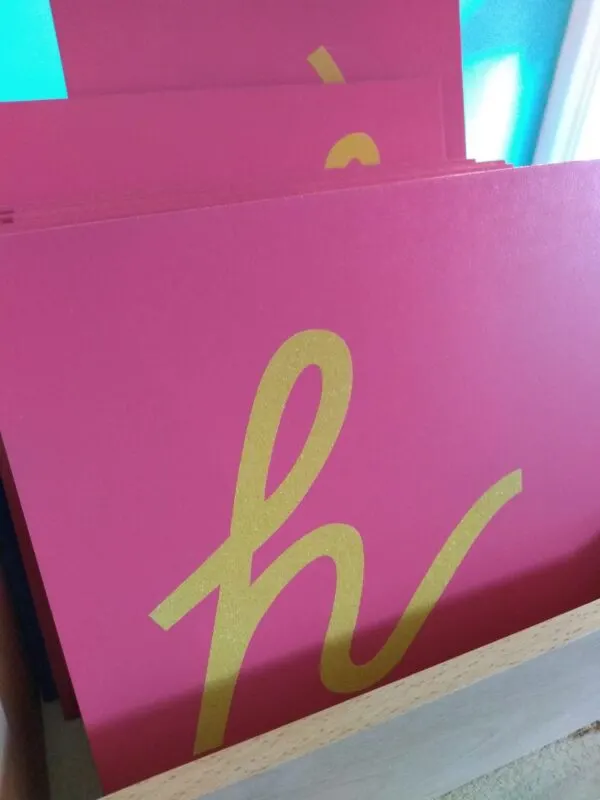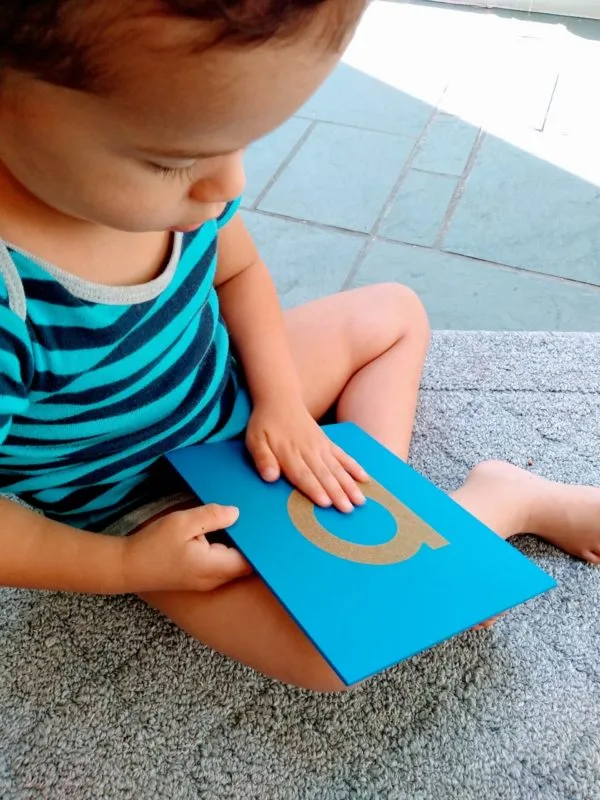How do Sandpaper Letters work?
If you've done any reading of Dr. Montessori's, you've likely come upon some of the brain-bending genii that inspired her to design the Sandpaper Letters. If you haven't, you might be still wondering, “How do Sandpaper Letters Work?“
Before we get into the introduction of the Montessori Sandpaper Letters, let me give you one of the most thorough explanations of this material, right from the Good Doctor herself:
“Tracing the letter, in the fashion of writing, begins the muscular education which prepares for writing…Touching the letters and looking at them at the same time, fixes the image more quickly through the cooperation of the senses. Later the two facts separate; looking becomes reading; touching becomes writing.” -Maria Montessori (The Montessori Method)
The Montessori Sandpaper Letters follow the sound games. They are the first concrete representation of a sound-symbol association. They give your child a visual representation, as well as a tactile (touch) impression of each letter symbol.
Along with these senses, comes the auditory (sound) impression your child gets when they here the letter sound as they trace it with their finger.

(This post contains affiliate links. Purchasing from these links costs you nothing extra, but sends a few cents our way for website upkeep.)
The Sandpaper Letters are definitely the cornerstone of the Montessori language arts materials. As explained above, this material is experienced through multiple senses.
This takes children beyond a visual recognition of letters and into a deeper understanding through a more thorough sensorial impression.
Most of the English language is phonetic, which makes learning the alphabet phonetically, instead of by the letter names, most crucial. A child simply cannot sound out a word without knowing the sound the letter produces.
This differs from traditional learning. Children who learn the names of the letters are really at a disadvantage when it some to learning how to read and write.
Montessori children learn quickly that words are simply a sequence of sounds to put together. This makes writing and reading make much more sense for children who learn their alphabet the phonetic way first.

The Montessori Sandpaper Letters
The Sandpaper Letters have the vowels in blue and the consonants in red to correspond to the colors in the Large and Small Movable Alphabets.
The precursor to the Sandpaper Letters in a formal Montessori setting would be the Touch Boards and other Montessori sensorial materials. These materials are quite useful for the Montessori homeschool environment.
These letters are introduced prior to the Sandpaper Numbers and are typically used at a table instead of a rug. This is to make it so your child doesn't have to lean over and can focus better on the sensation of tracing the letters.
How to introduce the Sandpaper Letters at home
Here is a list of the order in which the Sandpaper Letters should be introduced:
- m
- a
- s
- o
- t
- c
- e
- d
- p
- u
- f
- j
- g
- l
- b
- i
- n
- w
- r
- h
- y
- z
- q
- k
- v
- x
The Double Sandpaper Letter should be introduced as follows:
- ee
- ou
- th
- oa
- oo
- qu
- ai
- er
- ar
- ie
- sh
- oy
- au
- or
- ch
- ue
The following summarizes how to introduce the Sandpaper Letters:
- Pick three Sandpaper Letters and lay them on the left side of the table in a stack.
- Put the first letter in front of your child.
- Say (for example), “This is mmm”.
- With your left hand, starting on the left side of the letter, slowly trace the letter three times, saying the letter sound at the end of each tracing.
- Name some familiar objects that begin with the phonetic sound on the card.
- Ask your child if he would like to trace and make the sound three times, as well.
- Move the card away, but the next Sandpaper Letter in front of your child, and repeat the above steps.
- After the three letters have been traced, sounded out, and linked to familiar items, ask your child to trace a particular letter and hand it to you. Continue to discuss objects that begin with that phonetic sound.
- Repeat with the other letters on the table.
- After you feel your child is familiar with the three letters for the lesson, hand your child one of the letters and have them trace it and tell you what sound it makes. Then ask them if they can name some things that begin with that letter sound.
- Repeat with the other letters on the table.
On another day, introduce three more letters, making sure to review the previous letters, until the alphabet is complete!
Your lessons should be short and sweet; as much as your child can handle.
How Sandpaper Letters work in Montessori is nothing short of amazing. Giving your child the extra brain-boost of learning their letters using muscle memory and tactile sensation is part of the magic of a Montessori education!
Cheers and don't forget to subscribe!

Vanessa
Wednesday 18th of January 2023
Is there a reason to use your left hand?
Kathryn
Monday 7th of March 2022
Do you have any opinion on whether starting with lower case cursive is best?
Sue
Monday 7th of March 2022
Many in the Montessori community believe cursive is preferable to start with. I don't have any strong feelings about it, though it does seem easier for some children.
Fun Montessori Sound Games — Fun Montessori Sound Games
Sunday 27th of October 2019
[…] will be helpful to have the corresponding Sandpaper Letter, Movable Alphabet letter, or even just the letter written on a slip of paper. This is to help him […]
Why does Montessori Teach Writing Before Reading? — The Montessori-Minded Mom
Tuesday 22nd of October 2019
[…] Sandpaper Letters give the child a mental and physical impression of letter shapes, preparing them for […]